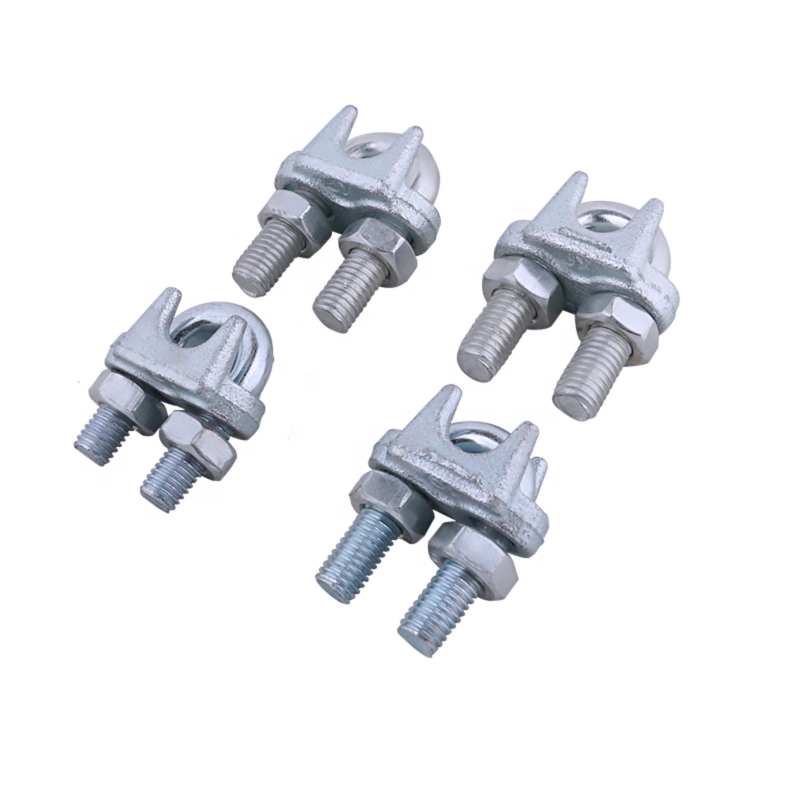## Table of Contents
1. Introduction to Suspension Clamps
2. Types of Suspension Clamps
3. Benefits of Suspension Clamps
4. Factors to Consider Before Choosing Suspension Clamps
5. Installation Guide for Suspension Clamps
6. Maintenance and Inspection of Suspension Clamps
7. Frequently Asked Questions (FAQs)
## 1. Introduction to Suspension Clamps
Suspension clamps play a crucial role in the electrical industry by securely holding overhead cables in place. They are designed to withstand various environmental conditions and ensure reliable electrical connections. Suspension clamps are commonly used in power transmission and distribution systems to provide support and stability to cables.
## 2. Types of Suspension Clamps
There are several types of suspension clamps available, each designed for specific applications and cable sizes. Some common types include:
### 2.1 Type A Suspension Clamps
Type A suspension clamps are widely used for bare conductor installations. They feature a robust design and are suitable for high-tension applications. These clamps provide excellent grip and prevent cable slippage.
### 2.2 Type B Suspension Clamps
Type B suspension clamps are specifically designed for insulated cables. They feature a protective layer to prevent damage to the cable's insulation. These clamps ensure a secure grip while maintaining the integrity of the cable.
### 2.3 Type C Suspension Clamps
Type C suspension clamps are ideal for applications where vibration damping is required. They are designed with rubber or elastomeric inserts to absorb vibrations and reduce stress on the cable. These clamps are commonly used in areas with high wind or seismic activity.
## 3. Benefits of Suspension Clamps
Suspension clamps offer various benefits in the electrical industry. Some key advantages include:
- Reliable Cable Support: Suspension clamps provide stable support to overhead cables, reducing the risk of sagging or damage.
- Easy Installation: These clamps are designed for easy installation, minimizing the time and effort required for cable setup.
- Enhanced Safety: By securely holding cables in place, suspension clamps contribute to a safer working environment, reducing the risk of accidents and electrical hazards.
- Durability: Suspension clamps are built to withstand harsh environmental conditions, ensuring long-lasting performance and reliability.
## 4. Factors to Consider Before Choosing Suspension Clamps
Before selecting suspension clamps for your specific application, consider the following factors:
- Cable Size and Type: Ensure that the suspension clamps you choose are compatible with the size and type of cable you are working with.
- Environmental Conditions: Consider the environmental factors like temperature, moisture, and UV exposure to select clamps that can withstand these conditions.
- Load Capacity: Determine the maximum load capacity required for your application to ensure the chosen suspension clamps can handle the load without compromising safety.
- Installation Method: Different suspension clamps may have specific installation requirements, so consider the ease of installation and any additional hardware needed.
## 5. Installation Guide for Suspension Clamps
Proper installation is crucial for the effective functioning of suspension clamps. Follow these steps for a successful installation:
1. Identify the suitable location for the suspension clamp, ensuring it provides secure support for the cable.
2. Prepare the cable by removing any debris, dirt, or oil that may affect the clamping performance.
3. Open the clamp and position it around the cable, ensuring a proper fit.
4. Close the clamp securely, making sure it firmly grips the cable without causing damage.
5. Verify that the suspension clamp is correctly aligned and provides adequate support to the cable.
6. Repeat the installation process for additional suspension clamps as required.
## 6. Maintenance and Inspection of Suspension Clamps
Regular maintenance and inspection of suspension clamps are essential to ensure their continued performance. Here are some key maintenance tips:
- Regularly inspect suspension clamps for signs of wear, corrosion, or damage.
- Clean suspension clamps using a mild detergent and a soft brush to remove dirt and debris.
- Lubricate moving parts, such as bolts and hinges, to prevent rust or stiffness.
- Perform load testing periodically to ensure the clamps can handle the specified load capacity.
- Replace any damaged or worn suspension clamps promptly to maintain the integrity of the electrical system.
## 7. Frequently Asked Questions (FAQs)
### 7.1 Can suspension clamps be used for both overhead and underground cables?
No, suspension clamps are specifically designed for overhead cables and should not be used for underground applications. Underground cables require different types of clamps and support structures.
### 7.2 How do suspension clamps prevent cable sagging?
Suspension clamps hold the cables at specific intervals, preventing excessive sagging caused by the weight of the cable. This ensures the cables maintain the required clearance from the ground or any other objects.
### 7.3 Are suspension clamps suitable for high-voltage applications?
Yes, suspension clamps are suitable for high-voltage applications. However, it is essential to select clamps that meet the required voltage rating and safety standards for your specific application.
### 7.4 Can suspension clamps be reused?
Suspension clamps can often be reused if they are in good condition and meet the necessary safety requirements. However, it is recommended to carefully inspect the clamps before reuse and test their performance to ensure reliability.
### 7.5 How often should suspension clamps be inspected?
Suspension clamps should be inspected regularly, ideally as part of a routine maintenance program. The frequency of inspections may vary depending on the environmental conditions and the load capacity of the clamps.
## Conclusion
In conclusion, suspension clamps are essential components in the electrical industry, providing reliable support and stability to overhead cables. By understanding the different types of suspension clamps, their benefits, installation guidelines, and maintenance practices, you can ensure the safe and efficient operation of your electrical system. Remember to consider the specific requirements of your application and choose suspension clamps that meet the necessary standards to achieve optimal results.
1. Introduction to Suspension Clamps
2. Types of Suspension Clamps
3. Benefits of Suspension Clamps
4. Factors to Consider Before Choosing Suspension Clamps
5. Installation Guide for Suspension Clamps
6. Maintenance and Inspection of Suspension Clamps
7. Frequently Asked Questions (FAQs)
## 1. Introduction to Suspension Clamps
Suspension clamps play a crucial role in the electrical industry by securely holding overhead cables in place. They are designed to withstand various environmental conditions and ensure reliable electrical connections. Suspension clamps are commonly used in power transmission and distribution systems to provide support and stability to cables.
## 2. Types of Suspension Clamps
There are several types of suspension clamps available, each designed for specific applications and cable sizes. Some common types include:
### 2.1 Type A Suspension Clamps
Type A suspension clamps are widely used for bare conductor installations. They feature a robust design and are suitable for high-tension applications. These clamps provide excellent grip and prevent cable slippage.
### 2.2 Type B Suspension Clamps
Type B suspension clamps are specifically designed for insulated cables. They feature a protective layer to prevent damage to the cable's insulation. These clamps ensure a secure grip while maintaining the integrity of the cable.
### 2.3 Type C Suspension Clamps
Type C suspension clamps are ideal for applications where vibration damping is required. They are designed with rubber or elastomeric inserts to absorb vibrations and reduce stress on the cable. These clamps are commonly used in areas with high wind or seismic activity.
## 3. Benefits of Suspension Clamps
Suspension clamps offer various benefits in the electrical industry. Some key advantages include:
- Reliable Cable Support: Suspension clamps provide stable support to overhead cables, reducing the risk of sagging or damage.
- Easy Installation: These clamps are designed for easy installation, minimizing the time and effort required for cable setup.
- Enhanced Safety: By securely holding cables in place, suspension clamps contribute to a safer working environment, reducing the risk of accidents and electrical hazards.
- Durability: Suspension clamps are built to withstand harsh environmental conditions, ensuring long-lasting performance and reliability.
## 4. Factors to Consider Before Choosing Suspension Clamps
Before selecting suspension clamps for your specific application, consider the following factors:
- Cable Size and Type: Ensure that the suspension clamps you choose are compatible with the size and type of cable you are working with.
- Environmental Conditions: Consider the environmental factors like temperature, moisture, and UV exposure to select clamps that can withstand these conditions.
- Load Capacity: Determine the maximum load capacity required for your application to ensure the chosen suspension clamps can handle the load without compromising safety.
- Installation Method: Different suspension clamps may have specific installation requirements, so consider the ease of installation and any additional hardware needed.
## 5. Installation Guide for Suspension Clamps
Proper installation is crucial for the effective functioning of suspension clamps. Follow these steps for a successful installation:
1. Identify the suitable location for the suspension clamp, ensuring it provides secure support for the cable.
2. Prepare the cable by removing any debris, dirt, or oil that may affect the clamping performance.
3. Open the clamp and position it around the cable, ensuring a proper fit.
4. Close the clamp securely, making sure it firmly grips the cable without causing damage.
5. Verify that the suspension clamp is correctly aligned and provides adequate support to the cable.
6. Repeat the installation process for additional suspension clamps as required.
## 6. Maintenance and Inspection of Suspension Clamps
Regular maintenance and inspection of suspension clamps are essential to ensure their continued performance. Here are some key maintenance tips:
- Regularly inspect suspension clamps for signs of wear, corrosion, or damage.
- Clean suspension clamps using a mild detergent and a soft brush to remove dirt and debris.
- Lubricate moving parts, such as bolts and hinges, to prevent rust or stiffness.
- Perform load testing periodically to ensure the clamps can handle the specified load capacity.
- Replace any damaged or worn suspension clamps promptly to maintain the integrity of the electrical system.
## 7. Frequently Asked Questions (FAQs)
### 7.1 Can suspension clamps be used for both overhead and underground cables?
No, suspension clamps are specifically designed for overhead cables and should not be used for underground applications. Underground cables require different types of clamps and support structures.
### 7.2 How do suspension clamps prevent cable sagging?
Suspension clamps hold the cables at specific intervals, preventing excessive sagging caused by the weight of the cable. This ensures the cables maintain the required clearance from the ground or any other objects.
### 7.3 Are suspension clamps suitable for high-voltage applications?
Yes, suspension clamps are suitable for high-voltage applications. However, it is essential to select clamps that meet the required voltage rating and safety standards for your specific application.
### 7.4 Can suspension clamps be reused?
Suspension clamps can often be reused if they are in good condition and meet the necessary safety requirements. However, it is recommended to carefully inspect the clamps before reuse and test their performance to ensure reliability.
### 7.5 How often should suspension clamps be inspected?
Suspension clamps should be inspected regularly, ideally as part of a routine maintenance program. The frequency of inspections may vary depending on the environmental conditions and the load capacity of the clamps.
## Conclusion
In conclusion, suspension clamps are essential components in the electrical industry, providing reliable support and stability to overhead cables. By understanding the different types of suspension clamps, their benefits, installation guidelines, and maintenance practices, you can ensure the safe and efficient operation of your electrical system. Remember to consider the specific requirements of your application and choose suspension clamps that meet the necessary standards to achieve optimal results.









